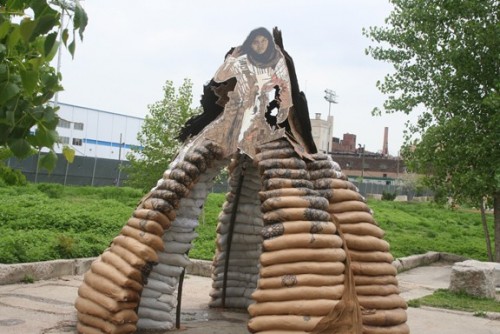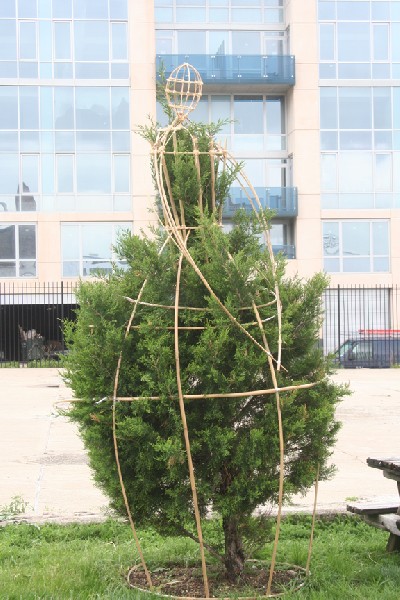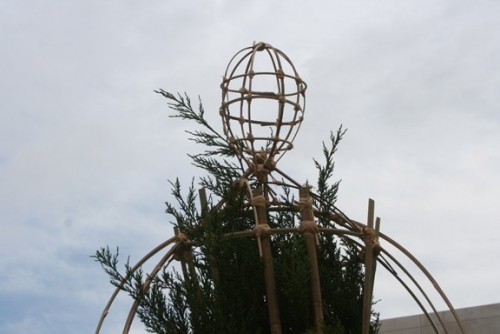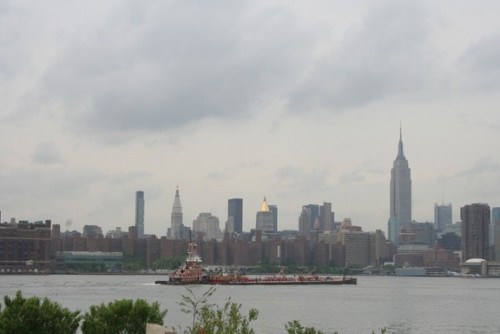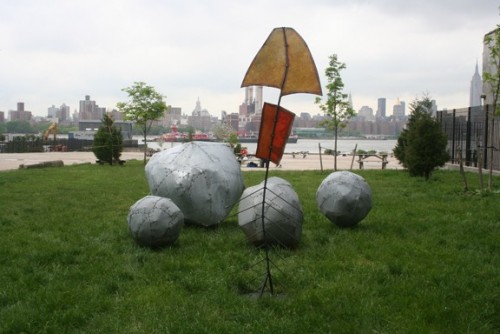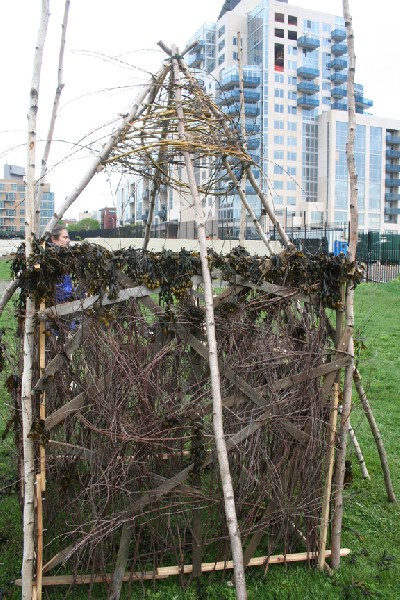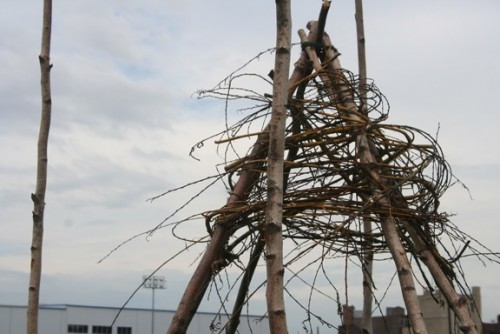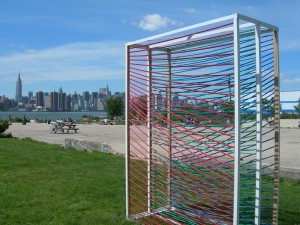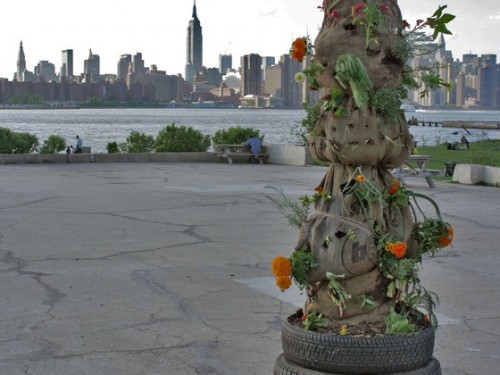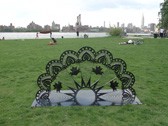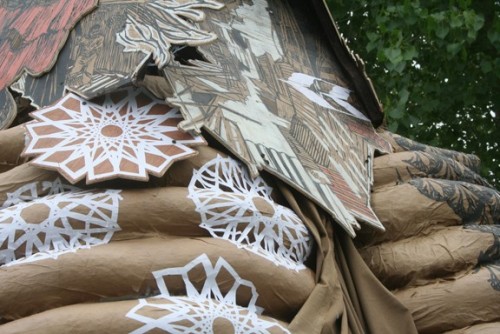Williamsburg Waterfront Sculpture Exhibition
Organized by Urban Arts Projects
By: Adam Zucker - May 24, 2010
Williamsburg Waterfront Sculpture Exhibition
East River State Park
Kent and N 8th street
Williamsburg, Brooklyn.
Urban Art Projects (UAP) is an emerging arts organization that was brought into existence by co-directors Martha Henry and Kim Vaadia. It is located in Williamsburg, Brooklyn. The idea behind this recent manifestation of a non-profit is to bring art and creative projects back into the urban environment. With the heavy gentrification and hipster traffic that exists within the geography of North Williamsburg, it is refreshing to see artists taking the neighborhood in a different direction.
Williamsburg had potential to become a thriving artist community much like SoHo and the East Village. It was just ten years ago when the area was full of abandoned factories and industry. Now the factories have been turned into high priced luxury condos and the industry is in jeopardy of being pushed out. This will leave many longstanding residents and working class people in disarray and the landscape disgraced by lousy architecture.
New York City has seen multiple shifts in artistic and creative communities usually thriving in areas where artists can afford lots of space for little money. The East and West Villages were pioneering art spots that gave birth to the New York School in the '50s, the Punk scene in the '70s, and the New Wave Vaudeville and Club Kid scene in the 80's and early '90s.
Today there are few traces of evidence left in the urban landscape that these scenes ever existed. These movements and their characters have become fragmented fantasies, a New York Fairy Tale. But nostalgia is useless; it is time to move forward with even greater strides. The arts are yearning again to thrive in New York City and Williamsburg seemed to be its next location. Unfortunately Williamsburg has fallen victim to a similar fate that has occurred in much of lower Manhattan, the arts are neglected for consumer culture. UAP is beginning to change all of this with new ways to use the public space through a creative means.
Last September, UAP organized an event that challenged the structure and the idea of the public space with a one-day event called "Perform Williamsburg." The event was a success as it raised the awareness to a group of people who were confronted with art, many possibly for the first time in ways they probably never thought possible.
Artists took the idea of the space as a public forum for expression and discourse with the urban environment, themselves, and whoever happened to be passing through while their performance was happening. This brought a series of pieces outside of the theater and galleries to be related to the real world. This time in the most recent project, there is no performance but the interaction is more permanent through sculptural installations that will occupy a predetermined space in the park.
In UAP's second exhibition, East River State Park is spread out with the work of eight artists including the popular and talented young artist Swoon. The exhibition will be up until June 6th and open daily to the public. Each piece will occupy its own space and its own mission for becoming a temporal relic that plays with and even in some cases enhances its surroundings. The park is being used for the "free play" of sculptors who envision an aesthetic new world for old New York, and ultimately beyond. The internationally renowned street artist Swoon headlines the exhibition. The other highly acclaimed artists, include Kathy Bruce, Ursula Clark, Rob De Oude, Nathan Slate Joseph, Howard Kalish, Wu Ming in Association with Littlefish Farm and one very promising emerging artist, Sarah Fonzi.
With a style celebrating independence, Swoon blends fine art and architecture to create works of personal dialogs and expressions of the world that she experiences and shares in the public space. Her contribution to the art world has already been great as a visual architect and humanist who has made powerful strides towards revitalizing visual expression and human interaction. While she has created massive installations "Swimming Cities of Switchback Sea," and "The Clutches of Cuckoo," (http://www.artinamericamagazine.com/news-opinion/the-market/2009-06-03/swoons-swimming-cities-crashes-the-venice-biennale/) based sailing vessels that served as a beacon for artist community and interaction, her piece for this exhibition is a prototype for a new utilitarian involvement with her art that transcends cultures and brings the art of the street to new humanistic terms. She has created a prototype of her dome shaped Konbit Shelter through working with a team of engineers and builders along the waterfront at East River State Park.
This building project is planned to take place later within the year in Haiti, as a communal cooperative healing effort for the community devastated by natural disaster. Her project that is a cross-cultural expression of compassion and unity will create a small neighborhood ring of adobe houses that server as fundamental housing structures to hold a family, or serve the needs of the community through becoming schools, or temporary medical facilities.
The process of rebuilding and nurturing those in need is vital of the human condition and this can be truly affirmed and seen through the visionary design and cathartic process of Swoon's art. Too rarely we hear of ambitious undertakings by determined young individuals that have more than money or fame on their minds. What is different amongst her work than in many important street artists is her narrative and ability to connect art and expressions with the real world. She is inspired by what she sees in the faces of the people she encounters and the local stories she hears about from first hand experience and interactions.
Swoon is a contemporary storyteller in a diverse urban world where fragmented culture is often misinterpreted through various media outlets. She has taken on the role of an international artist, a very big responsibility. Swoon is optimistic in her message and ideals to rebuild and reinvigorate the world through the process of art and communication.
Teaching others to come together under the idea that art can be the greatest creation of all and a necessity to preserving life, her efforts will inspire the community to make their own additions to the work and continue the dialog of survival. This is not only art history in the making but also human history progressing through what seems at times to be a very small light at the end of the tunnel. The project in Haiti will be a monumental task for Swoon and her team; the structure in the park is just the beginning. However, with the right amount of materials, architectural and engineering research I can see this being one of the most successful uses for contemporary art.
Wu-Ming and Littlefish Farm has also created a very functional experimentation that aims to use the aesthetic process of the visual artist with a green thumb for agriculture and empirical study of arts function between the natural and man-made environment. The artist works anonymously under his moniker and states:
nature is life
life is art
art is nature
no names needed
let's eat, shall we?
His "Tree of Life" is part sculpture, part ecosystem. It is an experiment on whether art can sustain two functions, one being an object of art in its highest regard and the other being something that can sustain itself both artistically and naturally. From May 8th for one mooncycle, two arboravita ('trees of life') will sprout out of the cement on the Williamsburg waterfront. A list of the crops groing thus far include: fruits/flowers : strawberry ~ marigold ~ calendula ~ agastache tuttifrutti herbs : mint (spear & cat) ~ greek oregano ~ holy basil ~ curry ~ yarrow ~ german chamomille ~ echinacea purpea ~ chives ~ stevia ~ lambs ear ~ red clover ~ purple sage ~ french lavender veggies : loves-lies-bleeding amaranth ~ onion (several varieties) ~ arugula ~ cactus ~ purslane ~ potato ~ kohlrabi ~ beets ~ brussel sprouts ~ red russian kale ~ beans.
The true value of art is always at question amongst artists. For Wu-Ming and Littlefish Farm art serves as means on which to "rediscover interwoven interdependence, mutual wealth creation & contribution, and a personal purposeful connection with the living beings that sustain & nourish us." While the piece will be temporary in this location, the sculpture will be moved with hopes of eventually finding a longer lasting home.
Bamboo and raffia provide the framework in Kathy Bruce's sculpture "Women Gazing at the Heavens." Her natural materials are connected together by hand and mounted on a juniper tree in the park. The piece sways and moves with the nuances of the natural environment, making an allegorical reference for traditional holistic views of the earth and its fertility. In front of the massive new condos this delicate piece stands its own, and counters the complexity of modern high rise bourgeois falsities with an honest and simple message. The sculpture will ultimately be taken down while the buildings and the landscape of our Earth changes drastically in an attempt to distract us from the inevitable mortality of life.
Rob De Oude's installation "Optic Motion/01" is a three-panel structure with each panel containing lines that point in different directions, creating a "consequent controlled pattern." This piece is one of the more technical in theory, but is successful in its simplicity to create a natural sense of movement in our perception that corresponds with our physical movements. Looking through it you get a very cool ripple effect, which compliments and plays with the motion and view of the water without obstructing it.
Howard Kalish's "Child" seems like an alien object in the park amongst first glance. It is concerned with being an analogous manifestation of the forms created in the universe. It works well in the natural environment because it feels right in its placement. It is open to the environment and changes perspective as you view it from different scenarios. While the artist had a hand in shaping its fundamental structure, it is ultimately crafted in the hands of the universe, not so dissimilar to what influences our natural world.
Ursula Clark uses all natural materials in her constructs. These sculptures becomes heavily influenced and formed through the environment they encompass. The artist's work is constantly added to by placing seaweed and elements the artist gathers from the waterfront. It sits parallel the Manhattan skyline but couldn't be more different. It is an intimate and humble connection with the earth rather than man's quest to defy nature.
Nathan Slate Joseph's installation consists of two parts. Both are made of steel that is coated with a material that aids in the process of their oxidation within the natural elements, which adds to their chromatic intensity. His large steel "Balls" vary in size, his "Little Big Fish" is symbolic of the disapearance of fish within the ecosystem.
The youngest artist in this exhibition is Sarah Fonzi, whose work "Machine Lace" completely stopped me in my tracks. It sits about two feet from the ground completely monochromatic in a sleek black coat, but it's presence can't be unnoticed. The work is inspired by the design of a doily constructed in the typically delicate bobbin lace method, but its construction suggests that this isn't meant to be something fragile. Beautiful and strong this statement is seemingly the artist's expression that she can hang with the established group and do it well!
The question that I consistently think about when viewing this exhibition is how can art remain an important interaction within the public space. And also what defines public space? In an urban environment the notion of public space can be deceiving and often times a "public space" will become privatized and be off limits (limited to viewing and enjoying only during regular park hours).
Even though the exhibition has temporal limitations, many of these works will live on. Both the "Konbit Shelter" and the "Tree of Life" will extend on to other locations where they will provide a lasting utilitarian function, and the other artists are sure to be seen again soon within the urban realm, defining and redefining what the term "public space" means. Perhaps Urban Art Projects will be an important element in the defining of neo-Williamsburg.
Overall, the neighborhood's controversy over gentrification and rezoning, artists or arts organizations haven't had much of a say until now. The need for public art in public space is obvious and it can be successful in giving back to the community, allowing the public to experience something out of the ordinary, a nice contrast to the open space sandwiched between industry and through allowing them to reclaim the space.
There seemed to be outstanding positive accounts by park visitors who had no trouble co-existing among the artwork. It will be very exciting to track the progress of this organization within the structures of the borough and beyond!

